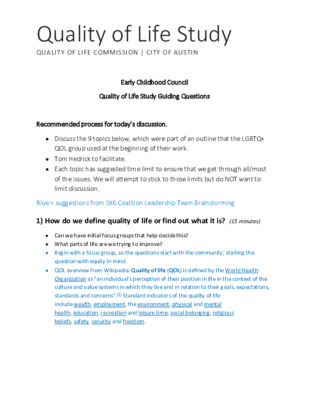Quality of life study guiding questions — original pdf
Backup

Quality of Life Study QUALITY OF LIFE COMMISSION | CITY OF AUSTIN Early Childhood Council Quality of Life Study Guiding Questions Recommended process for today’s discussion. • Discuss the 9 topics below, which were part of an outline that the LGBTQ+ QOL group used at the beginning of their work. • Tom Hedrick to facilitate. • Each topic has suggested time limit to ensure that we get through all/most of the issues. We will attempt to stick to those limits but do NOT want to limit discussion. Blue = suggestions from SX6 Coalition Leadership Team Brainstorming 1) How do we define quality of life or find out what it is? (15 minutes) • Can we have initial focus groups that help decide this? • What parts of life are we trying to improve? • Begin with a focus group, so the questions start with the community; starting the question with equity in mind. • QOL overview from Wikipedia: Quality of life (QOL) is defined by the World Health Organization as "an individual's perception of their position in life in the context of the culture and value systems in which they live and in relation to their goals, expectations, standards and concerns".[1] Standard indicators of the quality of life include wealth, employment, the environment, physical and mental health, education, recreation and leisure time, social belonging, religious beliefs, safety, security and freedom. 2 2) Goals – what does success look like? What do we want out of the study? (15 minutes) • Actionable: Need for concrete recommendations or a survey of strengths, gaps, desires? • Do we want to align with COA strategic direction areas? For more detail: https://www.austintexas.gov/edims/document.cfm?id=341820 • Accessible, readable story telling • Strengths-based power Analysis 3) How do we define boundaries/ scope: Whose quality of life are we trying to learn about? (10 minutes) • Who are the constituents that we are trying to study – o Age of children o Demographic characteristics (Family? Caregiver?) o Region • Define subgroups: o Language - people who speak languages other than English o Age groups - infants, 0-3, preschool, school age o Income • To what extent does lack of access leads families in our community to alter their career - how often would one parent choose to stay home? What aspect/ direction (Healthy beginnings, 0-3, specifically focusing on?) • What does it look like for parents who wish they could be home, when they have pressure to figure out care. The stability piece (housing & affordability), how can we get at the impact. Navigating displacement and providing for your family. 4) Design / Design Principles/ Process (5 minutes) Separate RFP for Recommendations? - Use of RFP for expert survey construction/implementation? - - Coordination with all or a subset of other JIC groups? - - Multiple modes of input/information gathering - Quantitative & Qualitative, mixed methods (surveys, focus groups, etc.) - Survey instrument design? Think about families with young children and time constraints, quick ways (text survey), letting them know what is happening in person 3 5) Deliverables (10 minutes) - Data driven state of early childhood survey results - Recommendations given the survey? Tell the story of the community (currently this is missing) - o Visuals o Quotes & Testimonials - Website - Report & Exec Summary - Video 6) Audience (5 minutes) Families Commission City council Schools Faith-based orgs - - - - - - Non-profits and service providers - Media 4 7) Equity Office (EO) Resources - Commission will own this process, EO will offer support - Support includes • navigating bureaucracy of the City • Advice 8) Challenges (10 minutes) Brevity vs. comprehensiveness Reaching difficult-to-reach communities/people - - Those inactive in the “community” Those that do not take advantage of services Creating an inclusive working group - involve important voices Open Data - Tricky to balance with anonymity - Want to be comprehensive, but too long might deter some potential responders - Must prioritize most critical purposes of survey 5 9) Commitments (10 minutes) Inclusivity & Accessibility - - - Serve the most vulnerable populations Committed to hearing the historically, systemically unheard voices Be mindful of varying accessibility and the inadvertent exclusion of some (ex: only social media) o Leverage agencies already providing services, canvas, community organize - Make results accessible in multiple mediums and languages, formats, styles, etc. - Use compelling, equitable incentives Consistent terminology Include a glossary - - What data do we already know and how do we know? What is missing from that data? Build a sense of purpose and trust Transparency of what data will be used for Both identify needs and provide with ways to address them This effort should be a useful tool/resource for the community - - - - Acknowledgment of limitations; This study is only one step of a long journey Build a sense of community Avoiding deficit model - Not a “Needs” Assessment, but a POWER Analysis Open-ended questions to let participants define needs - - - “What do you need?” “How do you feel current services/orgs serve you?” Commitment to unpacking hard questions/answers vs. just reporting flat stats Credibility - - - - Avoid complication, unrealistic list of recommendations; prioritize for tangible progress; make Statistical validity Respectable standards of data collection, analysis, and presentation It should be usable by other organizations - compatible with policy/procedure of CoA Strong example: Institutional Racism and Systemic Inequities Task Force report Produce both recommendations and principles Next steps Timeline from EO presentation: • October and November 2022- Visioning, planning, and the ECC establishing a workgroup • December 2022 and January 2023- Community engagement, town halls, establishing a scope of work for consultant, drafting a request for proposal (RFP) • Spring 2023- Initiate RFP and finalize consultants.